Struggling Tottenham Hotspur hosted bottom of the table Watford as both sides looked to find a positive result that would lift some of the gloom surrounding their respective starts to the season.
Mauricio Pochettino’s men have been a beleaguered force since the start of the season, with their ageing squad looking ever like they are no longer willing to go the full distance for the Argentine manager. Even with some impressive transfer business done, their results have been indifferent as the squad has looked stale and in need of a further overhaul. The underlying numbers do not point towards a team that is going to see a dramatic upturn in fortune any time soon.
Watford came into the fixture winless in their first nine games and rooted to the bottom of the table, having already changed managers as Quique Sanches Flores returned to the club for his second spell in charge of the Hornets. Despite propping the table up, the underlying numbers do not suggest a team that is playing particularly poorly, with xG and xGA data suggesting a team that looks more mid-table than relegation contenders. Unlike Spurs, this points to a team that can expect an upturn in fortune to come along shortly.
This tactical analysis will detail what was a fascinating fixture in North London, with a vital three points on offer for two struggling teams.
Lineups
Pochettino moved away from his 4-4-2 diamond system, one that has come under fire this season and set-up with a back three, perhaps anticipating Flores system that utilises two strikers – a move that the Spurs coach has deployed against the Spanish coach before. In a controversial team selection, perhaps with players returning from International duty in various states of fitness, as well as a Tuesday Champions League match to plan for, Heung-Min Son only made the bench, as did Tanguy N’Dombele who can already justifiably lay claim to be Spurs’ best central midfield option. Chief playmaker Christian Eriksen did not even make the bench.
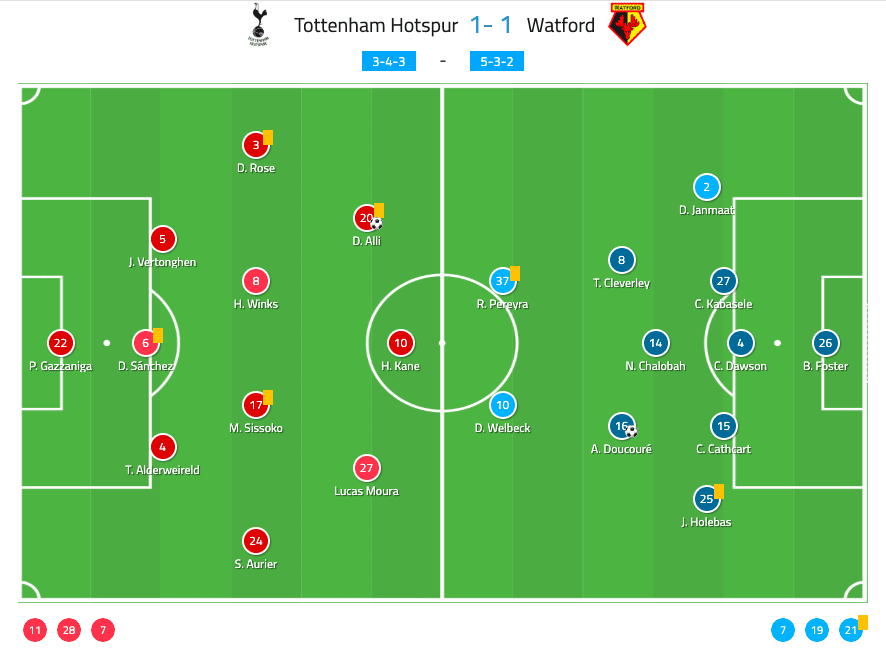
Flores selected a 5-3-2 system, as the Spaniard would look to stifle Spurs by sitting deep, and use the movement and mobility of ex-Arsenal forward Danny Welbeck and Roberto Pereyra, backed up by Abdoulaye Doucouré on the break. With Flores opting for a back five, the obvious tactical theme you would expect to become apparent was the battle between opposing wing-backs.
From the outset, it was clear how the pattern of play would develop during the game. Spurs in possession of the ball seeking to control the game, with Watford dropping deep, narrow and compact to control the space.
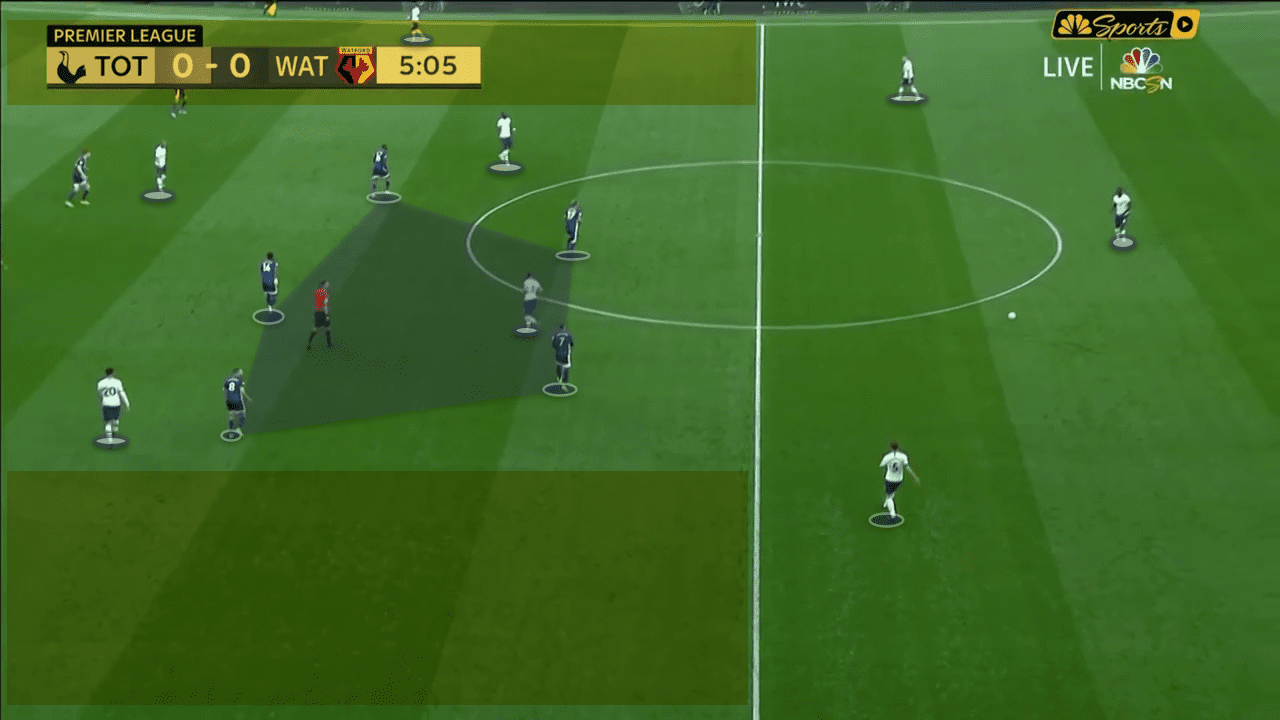
Here you can see Spurs back three fanned out, with Sissoko and Winks in central midfield and both wing-backs pushed up high and wide to occupy and pin back Watford’s defensive line. Lucas and Dele occupied narrow starting positions in support of Harry Kane, with the potential of creating a three v three up against Watford’s trio of centre-backs. One immediate issue that this clash of systems may create was Watford’s central midfield three outnumbering Spurs central midfield pair.
Watford dropped extremely deep, as you can see both centre-forwards have dropped well behind the halfway line ahead of the extremely narrow central midfield three. The plan was obvious, they would screen central passes and funnel Spurs out wide to their wing-backs. They were happy to surrender the wings where they surely reasoned that the declining Danny Rose and erratic Serge Aurier up against Holebas and Janmaat would not pose a significant threat 1v1. This was a sound ploy, and the question mark was over how Watford could transition to attack from their extremely low block.
Early goal for the Hornets
With Watford’s plan to spoil Spurs by playing deep and on the counter-attack, grabbing an early goal was the perfect start for the Hornets which would only serve to embolden their approach. The goal did not, surprisingly, come via a counter-attack, but what it did do was expose a horrendously disorganised Spurs back-line.
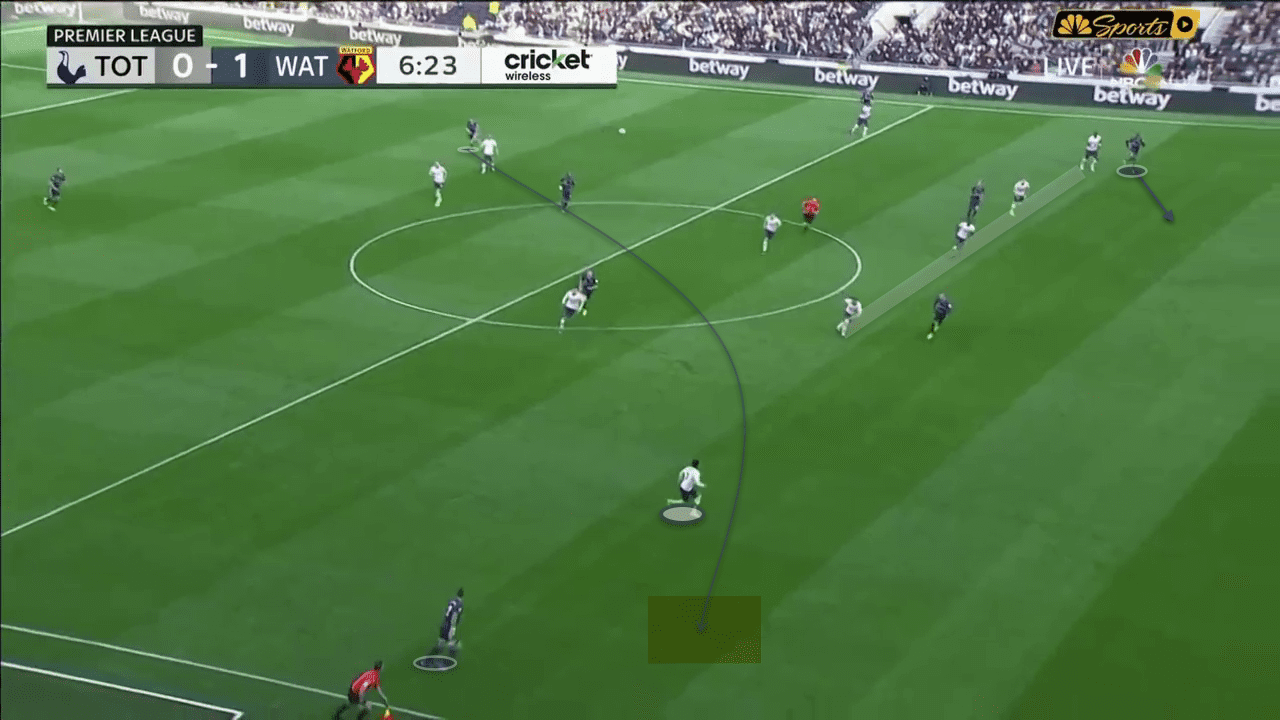
Craig Cathcart hit an inch perfect diagonal pass into the stride of Janmaat, catching Danny Rose under the ball. As you can see, Doucoure and Deulofeu (who replaced the injured Welbeck) are first to recognise the situation arising and steal ahead of the Spurs defensive line. They are caught way behind Danny Rose, and have not dropped immediately upon the diagonal pass being hit. Rose drops to deal with the ball and therefore means Deulofeu and Doucoure are now played onside.
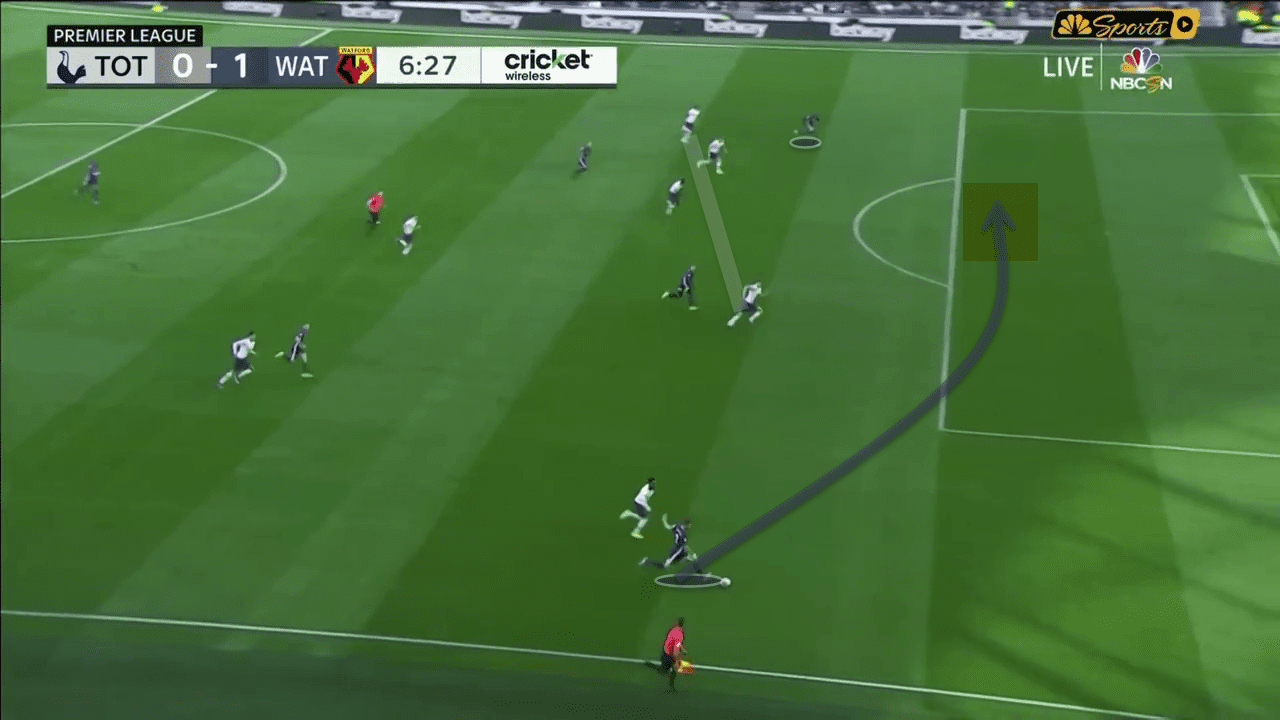
Janmaat takes a positive first touch to evade Rose, and then finds a perfectly hit cross to put the ball on a plate for Doucoure, with a pretty poor attempt at recovery runs from Aurier, Sanchez and Alderweireld. The irony in this goal was that it was Watford who exposed the isolated 1v1 on the wings with high and wide positioning from the wing-back in the build up phase.
Spurs issues in possession and defensive transition
At their best under Pochettino, Spurs’ press and possess game was suffocating for most opposition, but this game exposed yet again the frailties that have dogged them in recent times, when in possession and when they lose the ball.
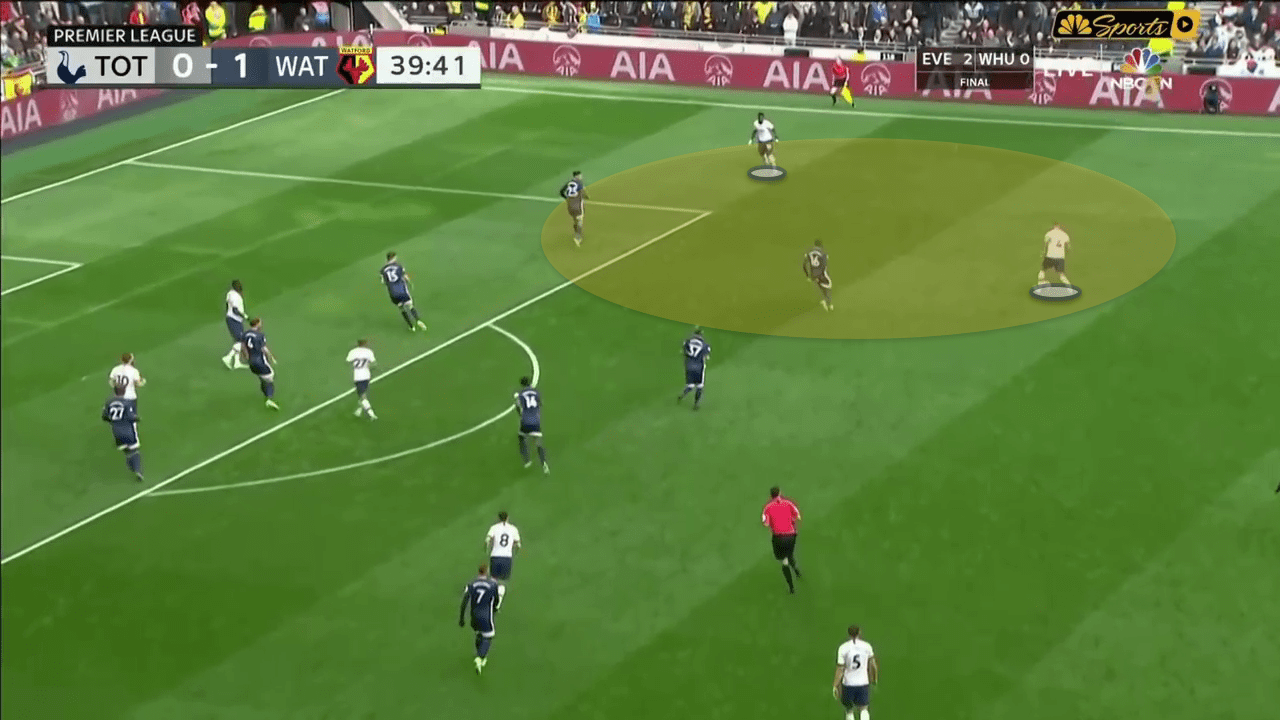
Throughout the first half, Alderweireld was allowed to advance with the ball into extremely high areas of the pitch due to Watford’s narrow approach. This created this 2v2 situation in advanced areas many times over. Despite being advanced high up the pitch, Aurier and Alderweireld are not the first players you would choose to be in a 2v2 situation in this position. Alderweireld is a fine passer from the back, but not a needle passer you want in this area to slot players in behind. Serge Aurier is also not the most proficient 1v1 dribbler who poses much threat in getting round his opponent. The result? Spurs resorted to shelling in crosses rather than picking apart Watford.
The next issue for Spurs came when they turned the ball over. At their best Spurs would hoover up counter-attacks with an aggressive counter-press and excellent positioning to contain them. This aspect of their game has fallen apart.
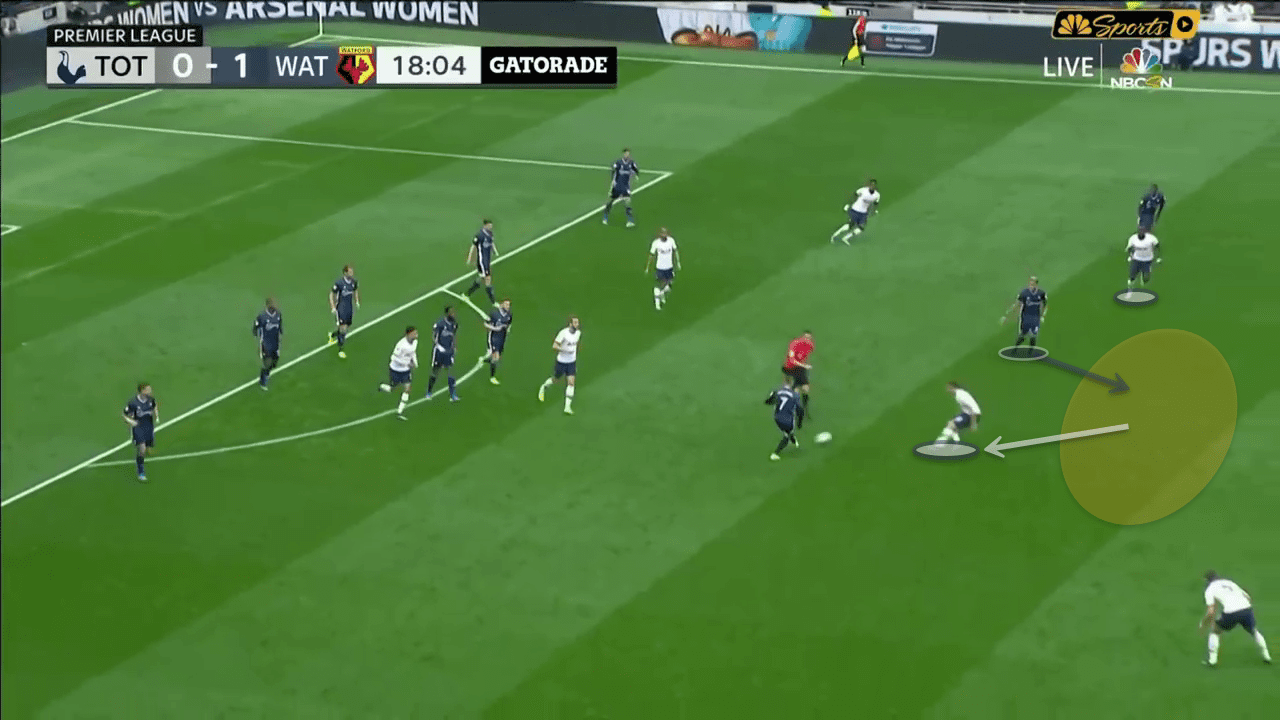
In this example, Spurs have just lost possession centrally and Harry Winks immediately jumps up to press the ball carrier. Whilst he is a willing presser and he immediately snaps into a defensive mindset, he is let down by his judgement as much as he is let down by Spurs lack of structure around him. Notice the space Winks leaves behind him, and the positioning of Moussa Sissoko – by pressing Winks makes the midfield two flat and easy to play through. Winks should probably have held his position and protect the space, as he did not have sufficient cover behind him to enact a successful press.
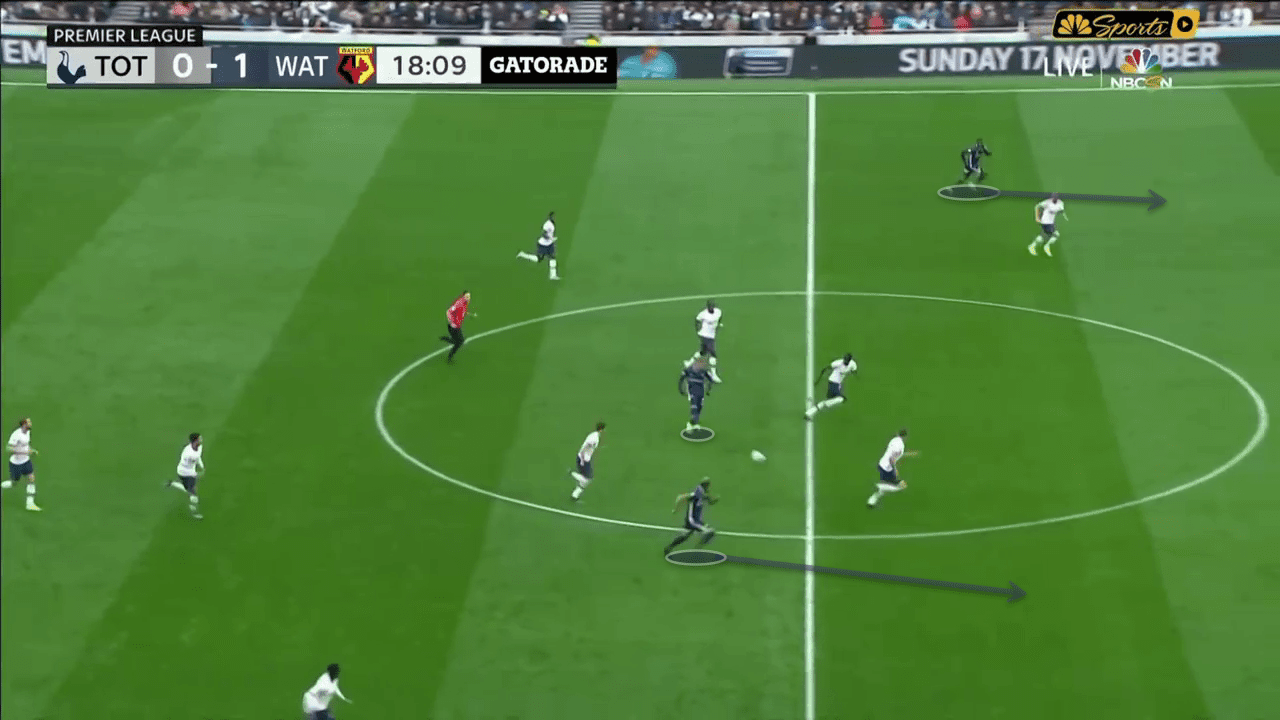
The result was this, Spurs midfield easily bypassed and suddenly are left exposed 3v3 at the back and everyone running back towards their own goal. This weakness in Spurs counterpress means they are rarely able to control games as they used to. This problem is twofold, as this allows their opponents to generate more attacks and shots on their goal, but even if the move breaks down as this one did, it creates messy games where team’s can relieve pressure on their defence. Spurs do not suffocate with pressure as they once did.
This example also shows nicely the counter-attacking strategy of Watford, attacking with three as the outside players both attack the space left in behind Spurs high and wide wing-backs. Notice Doucoure here, the left central midfielder once again taking up a high position running on the blindside of Alderweireld as he did for the opening goal. Perhaps this was a weakness Watford had spotted in the pre-match analysis.
Spurs half-time switch
At half-time Mauricio Pochettino decided to change shape and move to the 4-2-3-1 that has taken a bit of a backseat in recent times, bringing on Heung-Min Son for Davinson Sanchez. The reasoning was logical, Son now assumed a wide right position where he could hopefully isolate himself 1v1 up against Janmaat as Aurier was in the first half. Interestingly, Kane began the half as a number ten in behind Lucas Moura, who played as the lone striker on the last line of Watford’s defence.
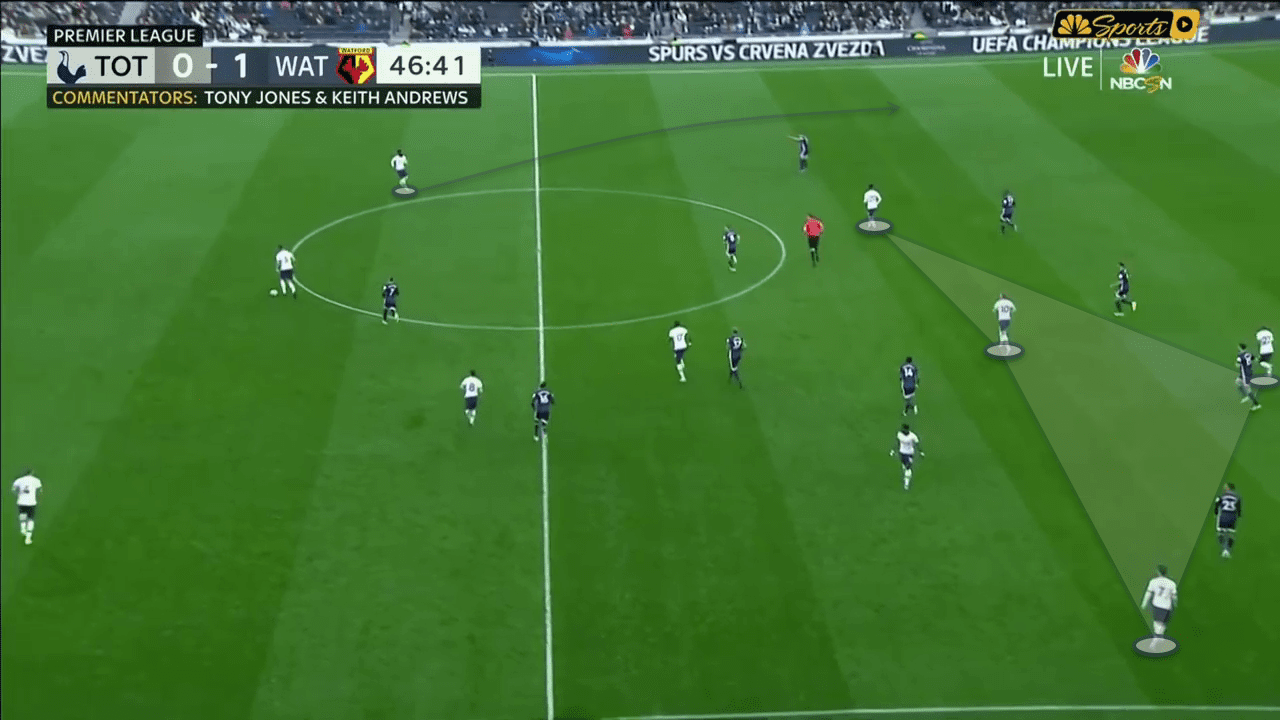
Son saw some immediate success as he rattled the crossbar, then danced beyond his opponent where he had a penalty appeal turned down. From a tactical standpoint, it was a good move changing system, however it can be asked why Pochettino did not begin in this shape with an extra attacking option against a deep block in the first place.
Here you can see the switch from Pochettino to a lopsided 4-2-3-1, where Son would stay wide and look to isolate himself against the full-back, whereas Dele operated from an inside left position in-between the lines and closer to Kane and Lucas. This would leave space for Danny Rose to overlap from deep.
Whilst Spurs immediately became slightly more of an attacking threat, the counterpress issues remained and Watford still looked like they could pose a threat on the break, however with their lead in tact they were cautious in not sending too many players forward in counter-attacking scenarios.
Watford discipline
Whilst Spurs issues were clear throughout, Watford must take great credit for the defensive discipline they showed throughout, holding their 5-3-2 shape out of possession extremely well. In this instance they have funnelled Spurs play down the right flank, and keeping an extremely compact shape to block Spurs progress.
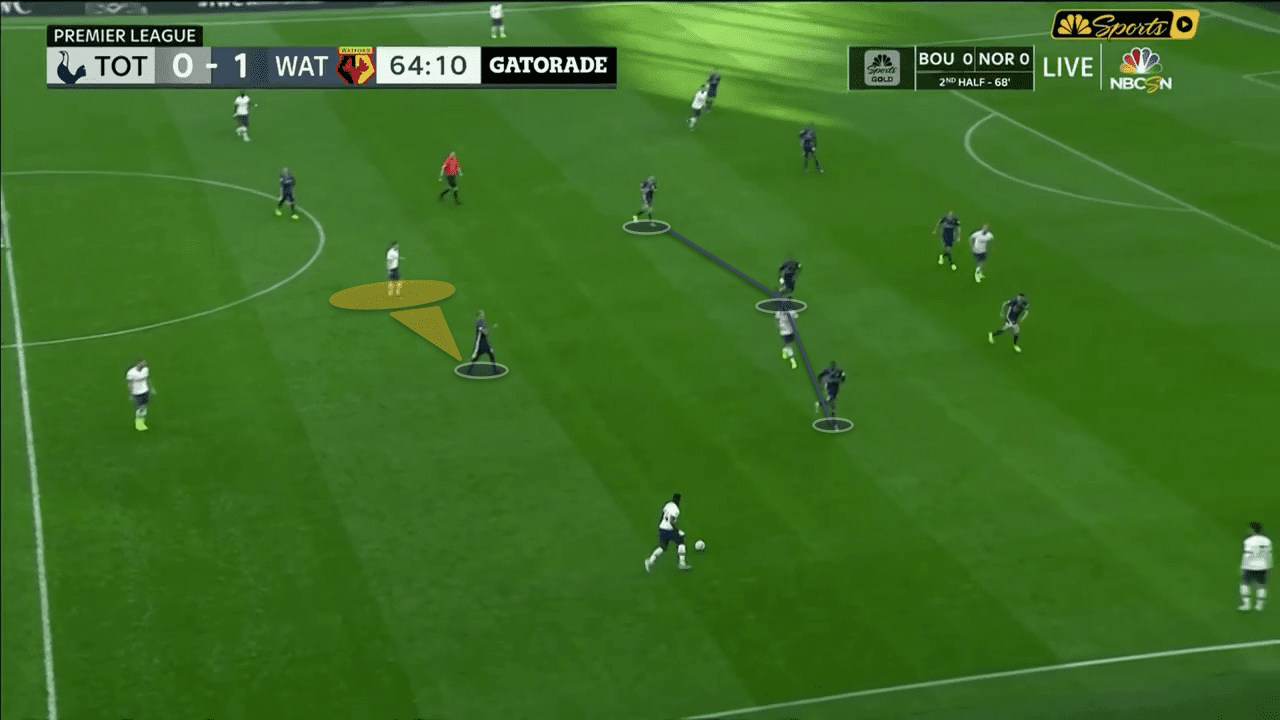
The midfield three have shifted quickly to the ball side, keeping extremely close distances as both strikers have dropped deep to screen Winks, who is Spurs best option to switch the play to the opposite flank to attack their weak side. Watford were happy to allow Spurs to build down the right, despite Spurs danger man Son on that side – the reason being that as Watford were so compact that the Korean would have to escape not only his marker but also nearby covering defenders. Had they forced Spurs to build down the left, a switch of play would mean Son is isolated 1v1 against the full-back. This tactic and Watford’s discipline to carry it out made Spurs ponderous in possession and unable to progress the ball centrally.
Pochettino made one last throw of the dice, and Son was this time on the move to a central role, up alongside Kane as Lucas was replaced by Lamela which created a narrow 4-4-2.
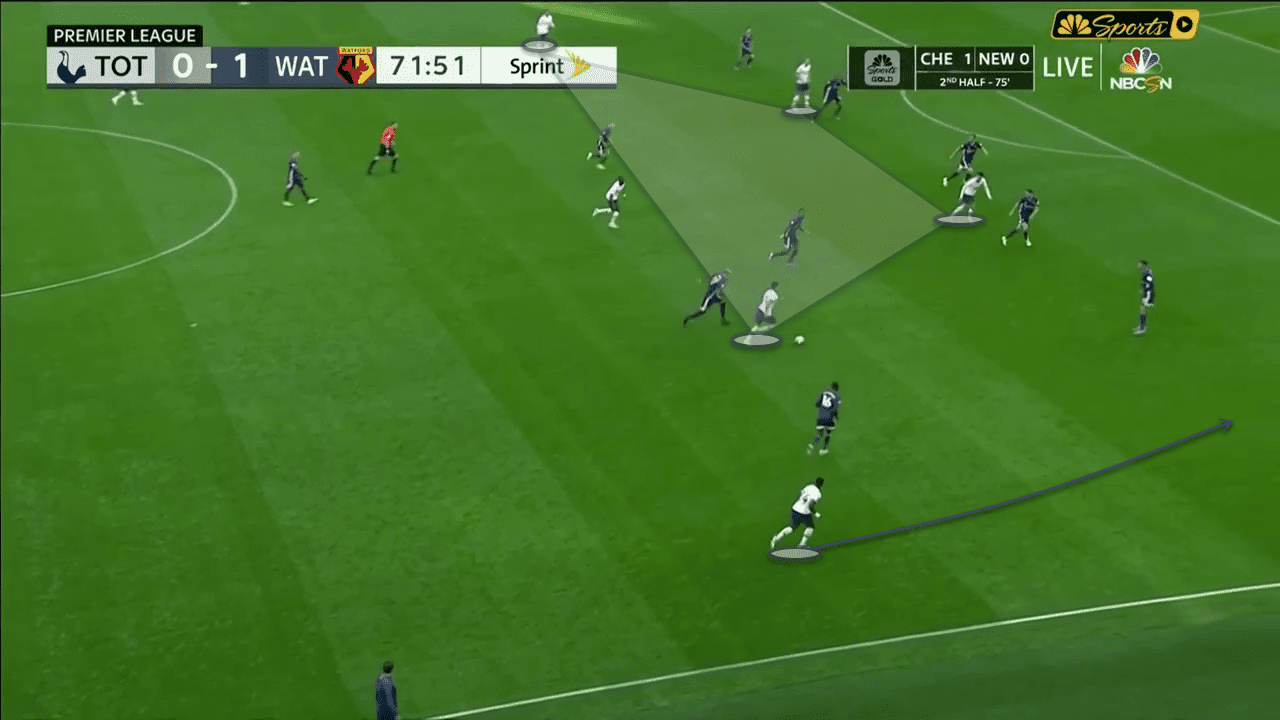
This change made Spurs attacking threats narrow, with width once again being provided by Aurier and Rose, however this led to further hopeful crossing into the box – Spurs made 40 crosses in the game, and rarely threatened from them.
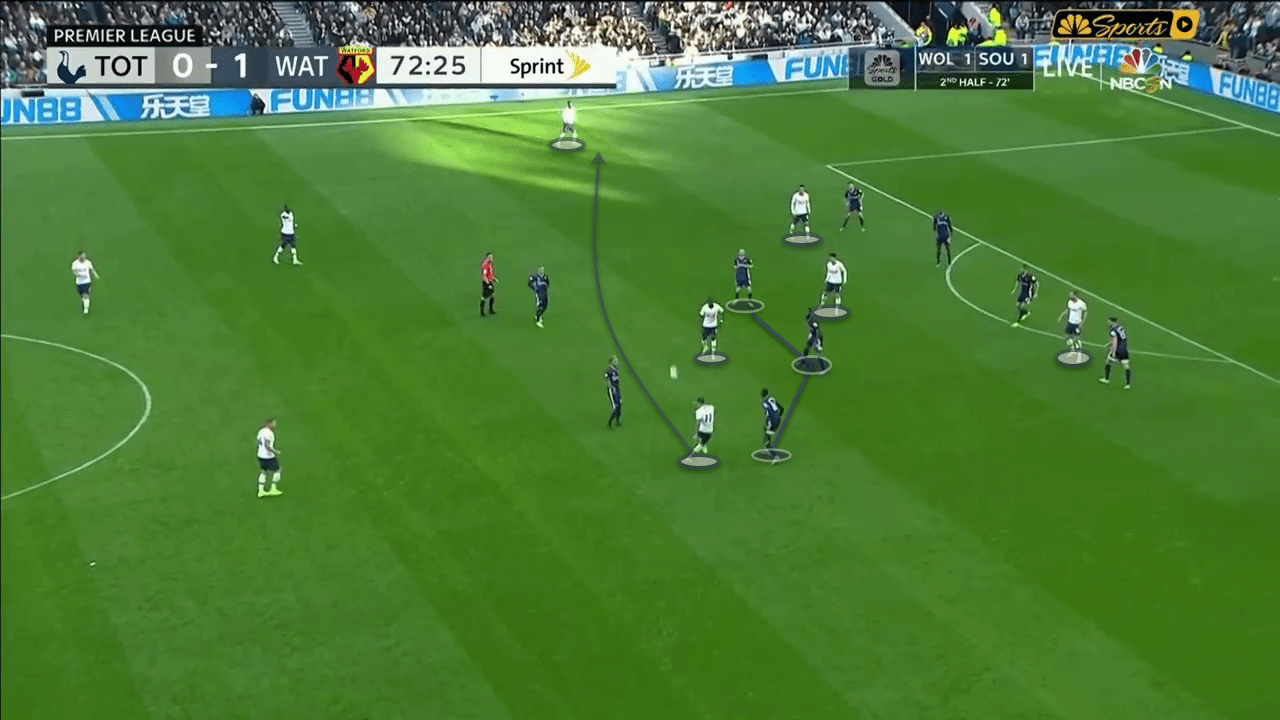
Once again Spurs main attacking options are bunched together in a not particularly well organised fashion, where they are caught looking at the ball with no one offering a threat in behind. Watford’s midfield screen continued to work in preventing Spurs to find their forwards feet to combine centrally, and once again the ball was played out wide to Rose who once again crossed into the box.
This continued until Spurs eventually made a breakthrough, owing to an embarrassing miscommunication between Watford goalkeeper Ben Foster and Kiko Fermenia, which allowed Dele to steal in and equalise (after a VAR check).
Conclusion
Watford will naturally come away from Tottenham the happier of the two sides, despite almost having held on to all three but for one defensive mishap. Spurs will take heart from the fact they were able to salvage something from the game, yet once again there were significant issues with their tactics that they cannot ignore.
The Hornets were fantastically disciplined throughout the game, suggesting the squad is already buying into Flores methods and despite not sending a huge many men forward in order to preserve their lead, they still maintained a threat on the break throughout. Indeed, until the last ten minutes, the Understat xG timing chart suggests Watford were the more threatening team throughout. If they can maintain this level throughout the season, they should be able to claw their way out of Premier League relegation trouble.
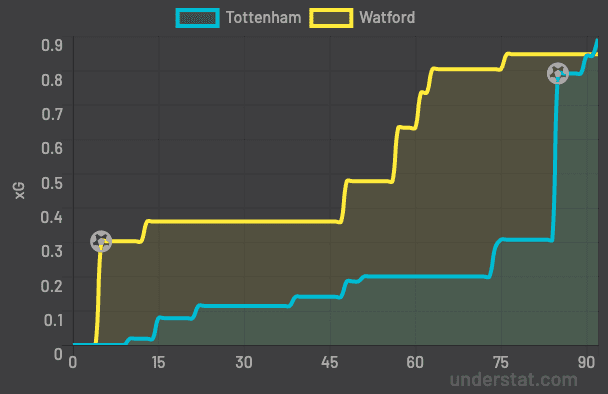
For Spurs, there are more questions than answers at the moment after another worrying display. This game in many ways resembled a lot of Spurs games in recent years, where they dominated the ball and the territory yet they simply do not have both the quality, physicality and hunger to carry out that same game model of press and possess any longer. It looks ever more likely that Spurs may need to experience some more pain this season before a more thorough overhaul over the next few transfer windows.
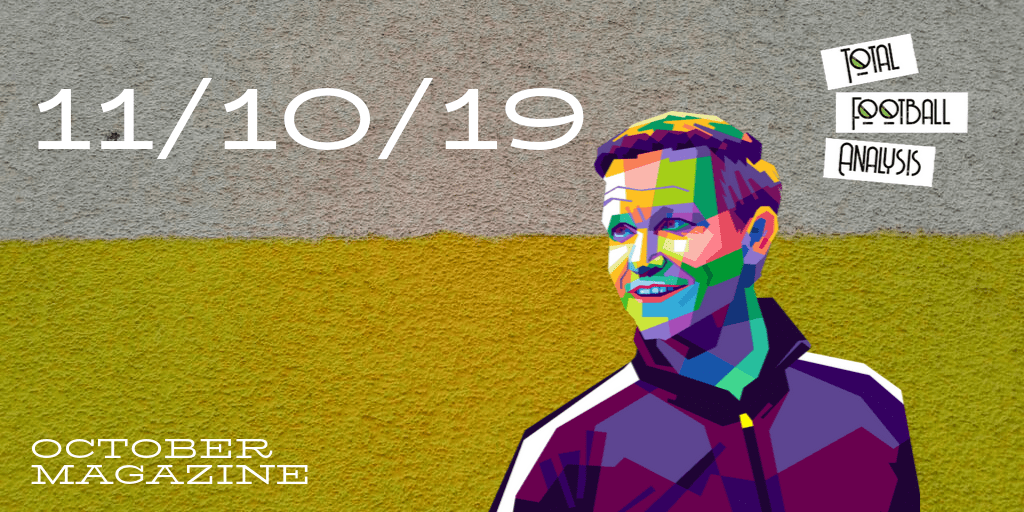
If you love tactical analysis, then you’ll love the digital magazines from totalfootballanalysis.com – a guaranteed 100+ pages of pure tactical analysis covering topics from the Premier League, Serie A, La Liga, Bundesliga and many, many more. Buy your copy of the October issue for just ₤4.99 here





Comments